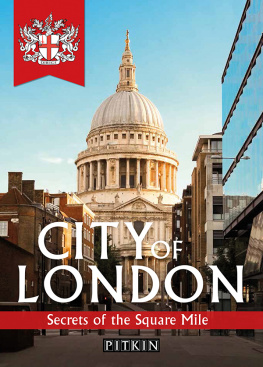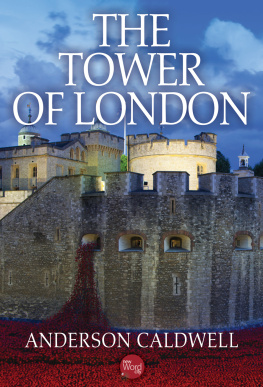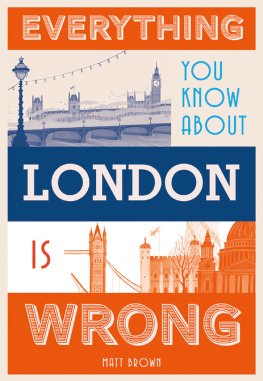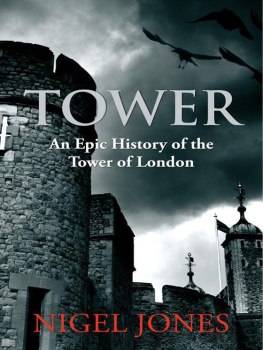Davis John Paul - A Hidden History of the Tower of London
Here you can read online Davis John Paul - A Hidden History of the Tower of London full text of the book (entire story) in english for free. Download pdf and epub, get meaning, cover and reviews about this ebook. year: 2020, publisher: Pen & Sword Books Limited, genre: Non-fiction. Description of the work, (preface) as well as reviews are available. Best literature library LitArk.com created for fans of good reading and offers a wide selection of genres:
Romance novel
Science fiction
Adventure
Detective
Science
History
Home and family
Prose
Art
Politics
Computer
Non-fiction
Religion
Business
Children
Humor
Choose a favorite category and find really read worthwhile books. Enjoy immersion in the world of imagination, feel the emotions of the characters or learn something new for yourself, make an fascinating discovery.
- Book:A Hidden History of the Tower of London
- Author:
- Publisher:Pen & Sword Books Limited
- Genre:
- Year:2020
- Rating:5 / 5
- Favourites:Add to favourites
- Your mark:
- 100
- 1
- 2
- 3
- 4
- 5
A Hidden History of the Tower of London: summary, description and annotation
We offer to read an annotation, description, summary or preface (depends on what the author of the book "A Hidden History of the Tower of London" wrote himself). If you haven't found the necessary information about the book — write in the comments, we will try to find it.
A Hidden History of the Tower of London — read online for free the complete book (whole text) full work
Below is the text of the book, divided by pages. System saving the place of the last page read, allows you to conveniently read the book "A Hidden History of the Tower of London" online for free, without having to search again every time where you left off. Put a bookmark, and you can go to the page where you finished reading at any time.
Font size:
Interval:
Bookmark:

A Hidden History of the Tower of London
Englands Most Notorious Prisoners
John Paul Davis

First published in Great Britain in 2020 by
Pen & Sword History
An imprint of
Pen & Sword Books Ltd
Yorkshire Philadelphia
Copyright John Paul Davis 2020
ISBN 978 1 52676 176 7
eISBN 978 1 52676 177 4
Mobi ISBN 978 1 52676 178 1
The right of John Paul Davis to be identified as Author of this work has been asserted by him in accordance with the Copyright, Designs and Patents Act 1988.
A CIP catalogue record for this book is available from the British Library.
All rights reserved. No part of this book may be reproduced or transmitted in any form or by any means, electronic or mechanical including photocopying, recording or by any information storage and retrieval system, without permission from the Publisher in writing.

Pen & Sword Books Limited incorporates the imprints of Atlas, Archaeology, Aviation, Discovery, Family History, Fiction, History, Maritime, Military, Military Classics, Politics, Select, Transport, True Crime, Air World, Frontline Publishing, Leo Cooper, Remember When, Seaforth Publishing, The Praetorian Press, Wharncliffe Local History, Wharncliffe Transport, Wharncliffe True Crime and White Owl.
For a complete list of Pen & Sword titles please contact
PEN & SWORD BOOKS LIMITED
47 Church Street, Barnsley, South Yorkshire, S70 2AS, England
E-mail:
Website: www.pen-and-sword.co.uk
Or
PEN AND SWORD BOOKS
1950 Lawrence Rd, Havertown, PA 19083, USA
E-mail:
Website: www.penandswordbooks.com
W hen William the Conqueror first laid eyes on the City of London in the late autumn of 1066, he did so sound in the knowledge that only one obstacle stood in the way of his being crowned undisputed king of England. On leaving his newly-assembled garrison at Dover and beginning the long march west through the Saxon-dominated Home Counties, representatives of the surrounding cities and boroughs wasted little time in coming forth to pledge allegiance to their new Norman overlord, choosing fragile peace as the preferred alternative to ongoing war.
Not so, the citizens of London. Whether the victor of Hastings was initially aware of the rushed election of the young Edgar theling as Harold Godwinsons successor nephew of the late Edward the Confessor and, as his closest living relative, possessed of a better claim to the throne than Harold himself on Williams arrival the realities of the situation became instantly clear. Behind the imposing Roman city walls where the survivors of Hastings and their uninjured relatives had further enlarged the local population, hatred for the invaders was high. Eyewitness accounts indicated that on reaching the walls of the city, the advance guard that William dispatched had been met with levels of antagonism not experienced since his victory at Hastings. When the fighting was finally over, Londons citizens mourned a heavy loss, and with it Edgars hopes of kingship. As the conqueror moved swiftly onward, nullifying all further threats while, at the same time, preparing for his coronation, the advance guard was assigned a new task: to construct a fortress as a defence against the inconstancy of the numerous and hostile inhabitants.
Like other fortifications William erected in London that year, this one would only be temporary. Chosen for its strategic importance, located towards the citys south-east corner where Alfred the Greats rebuilt wall continued to stand tall and where the ancient fort Arx Palatina had been established in the fourth century, the setting was practically perfect. Assisted by the engineering genius of Englands earlier rulers and the natural defences of the north bank of the Thames, as well as being enclosed by a deep ditch and a timber palisade, Williams defence against the hostile inhabitants was achieved on all sides. In doing so, it marked the beginning of the Tower of Londons 1,000-year dominance over Englands history.
Unlikely though it is that Englands new king could have envisioned that such an unremarkable timber assembly would one day lead to the formation of a building around which the nations destiny would always revolve, even in its early days the Tower was clearly conceived with defence in mind. Within twelve years of the Norman invasion, work was already in place on constructing a massive stone keep behind the wooden palisade, which by the next century had become famed as the citys undisputed focal point. Rising 27 metres into the air and with walls over 15 feet thick, Williams typically Norman keep was malevolent yet awe-inspiring, dominating not only the London skyline but also the thoughts of those who bore witness. Nothing of the type had ever been seen in England, nor did construction stop there. Many of Englands monarchs destined to follow in the Conquerors footsteps would add to the structure, culminating in an incredible twenty-one additional towers being placed around the original, all in their own way contributing to what by the fourteenth century had become a unique architectural masterpiece of seemingly unlimited uses. In more recent times, the Royal Commission on Historical Monuments maintained this view, describing the Tower as the most valuable monument of medieval military architecture in England.
Looking back now, exactly what the Towers primary purpose was is difficult to summarize. Writing in the late-sixteenth century, the antiquarian John Stow paid testament to the castles adaptability, recording:
this Tower is a citadel to defend or command the city; a royal palace for assemblies or treaties; a prison of state for the most dangerous offenders; the only place of coinage for all England at this time; the armoury for warlike provision; the treasury of the ornaments and jewels of the crown; and general conserver of the most records of the kings courts of justice at Westminster.
Had Stow been writing in the modern day, he might well have added how it had played host to diverse royal functions as well as serving as an observatory, menagerie, place of capital punishment, and a popular museum. The Royal Mint that existed in the outer walls between the thirteenth and nineteenth centuries may have long since been remodelled as homes for the Towers loyal guards, the amazing Yeoman Warders, yet for over 600 years it was the chief economic centre of the entire nation. The buildings that made up the heart of the Tower menagerie and royal apartments no longer stand, but as late as the reign of Charles II the setting was deserving of similar prestige as London Zoo or Windsor Castle. The modern bank vault in the Waterloo Block has been dubbed the most secure in all of Europe and was even used to house the Olympic medals in 2012. To this day, the Crown Jewels still reside at this, the cornerstone of the United Kingdom.
Yet, despite its direct or indirect involvement in almost every aspect of English political life and developing itself a reputation as a building fit for many purposes, even at a casual glance, one disturbing trend clearly repeats itself. Although never designed specifically to include dungeons or torture chambers, the graffiti that marks the walls of its dimly lit chambers bear testament to the darker aspects of its history. The countless suits of medieval armour that line the interior of the White Tower, like the instruments of torture that do the same in the Wakefield, serve as clinical reminders of the Towers affiliation with war in the same way each ruggedly engraved name of a former prisoner acts as a morbid complement to the memorials on Tower Green and Tower Hill that forever remind us that an Englishmans castle was not necessarily one to be enjoyed. No sadder spot on earth were the words used by the esteemed nineteenth-century historian Lord Macaulay to describe the royal Chapel of St Peter ad Vincula: an opinion not particularly surprising since of the sixty-three former Tower inhabitants interred there, only nine lie entombed with their heads intact. Perhaps equally disturbing is the castles reputation for extraordinary levels of paranormal activity. If the tales are to be believed, no less than thirty spectres are recorded to have appeared in nightly vigil, the majority striking apparently uncanny similarities to its known victims of cruel, if not always unjust, punishment.
Font size:
Interval:
Bookmark:
Similar books «A Hidden History of the Tower of London»
Look at similar books to A Hidden History of the Tower of London. We have selected literature similar in name and meaning in the hope of providing readers with more options to find new, interesting, not yet read works.
Discussion, reviews of the book A Hidden History of the Tower of London and just readers' own opinions. Leave your comments, write what you think about the work, its meaning or the main characters. Specify what exactly you liked and what you didn't like, and why you think so.













